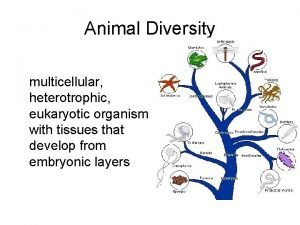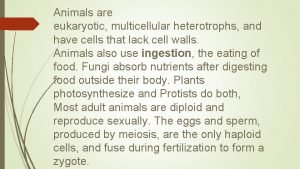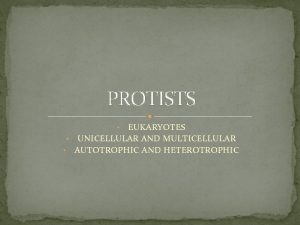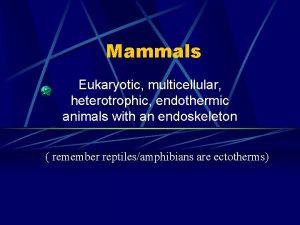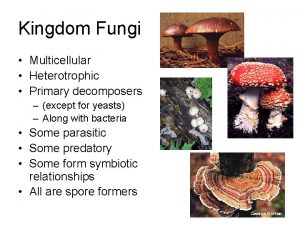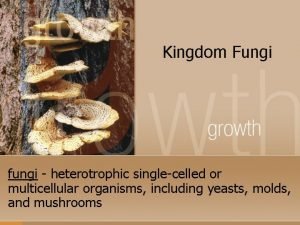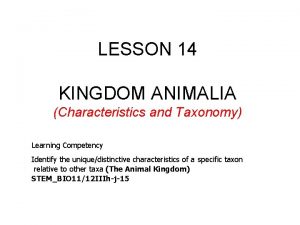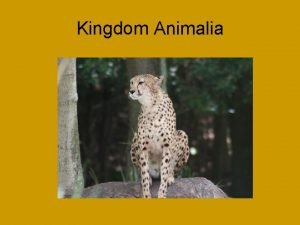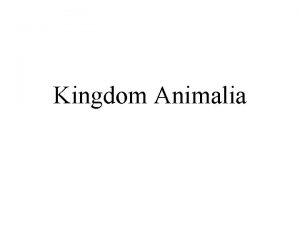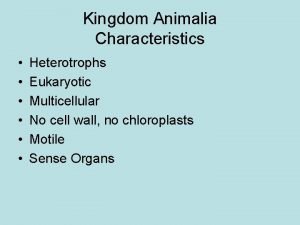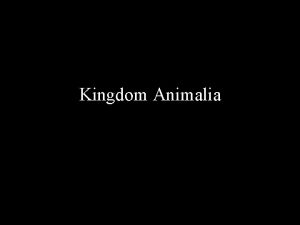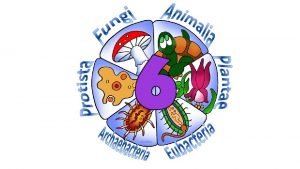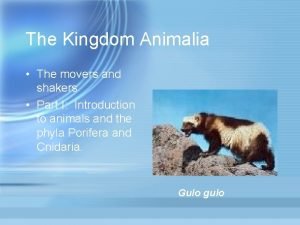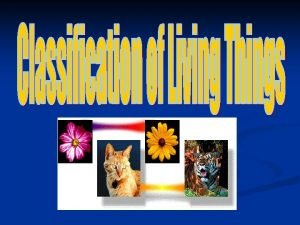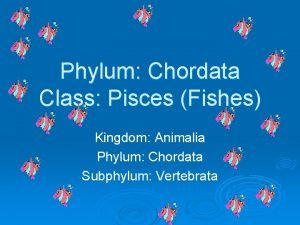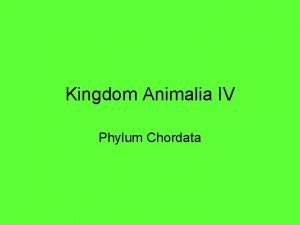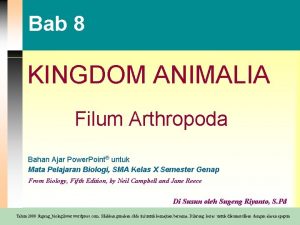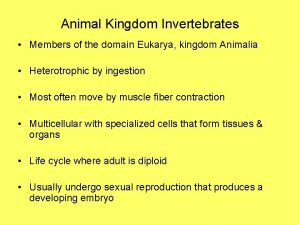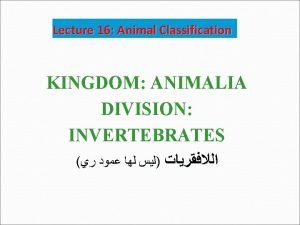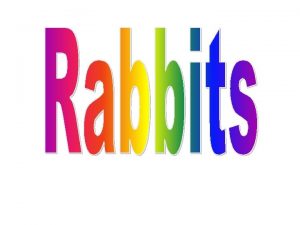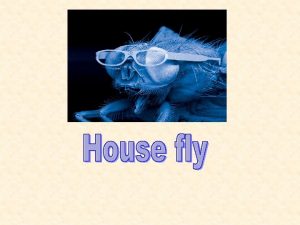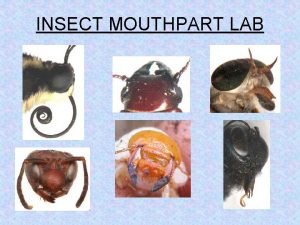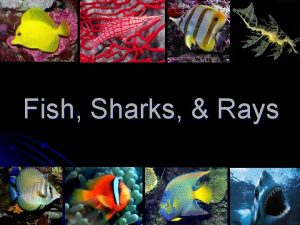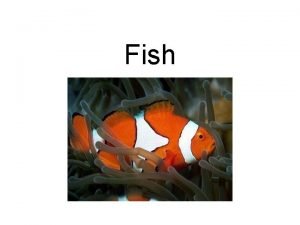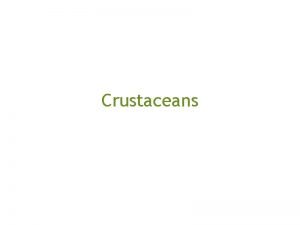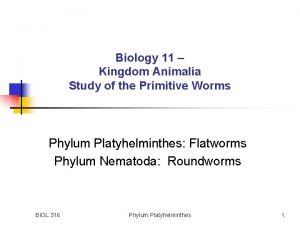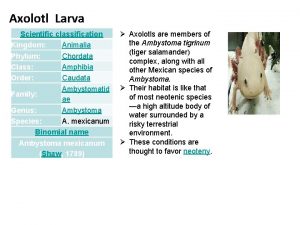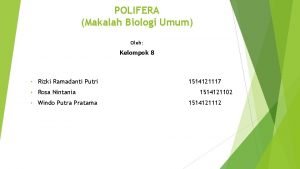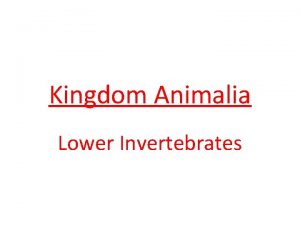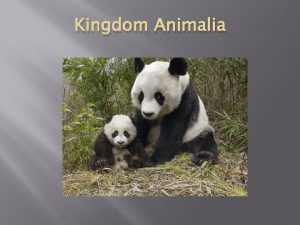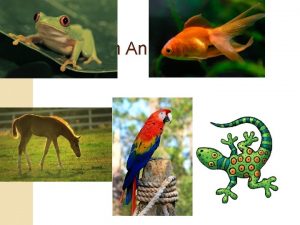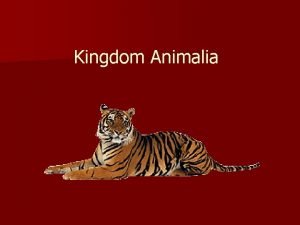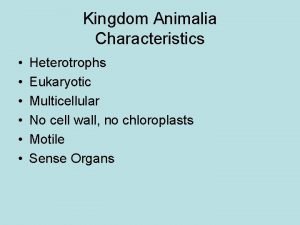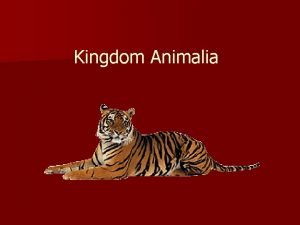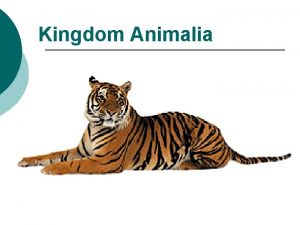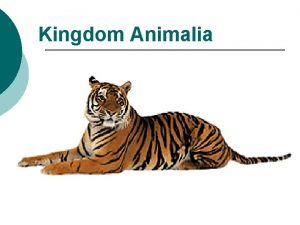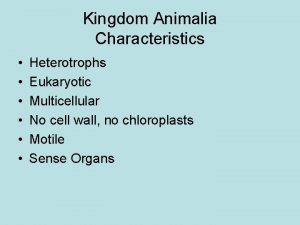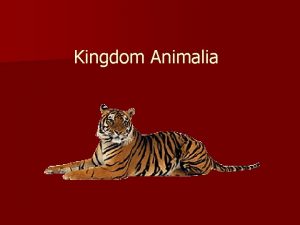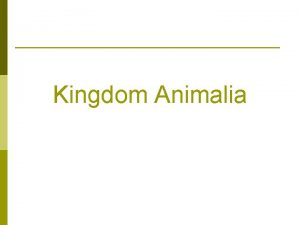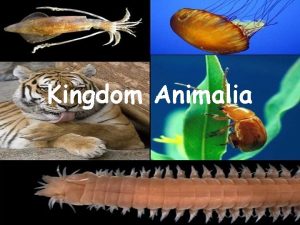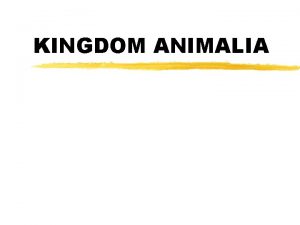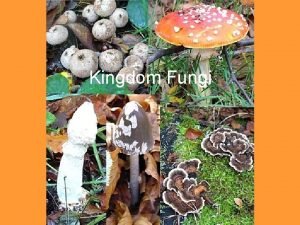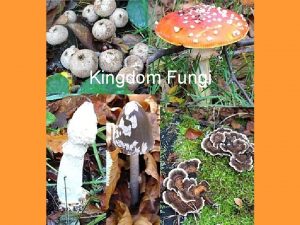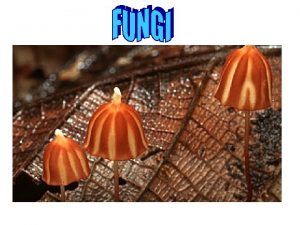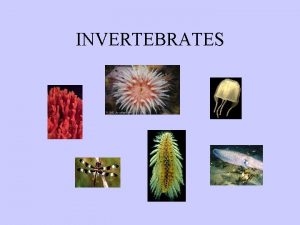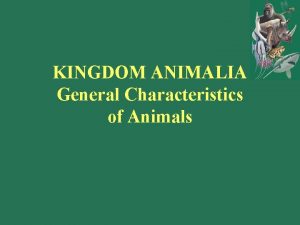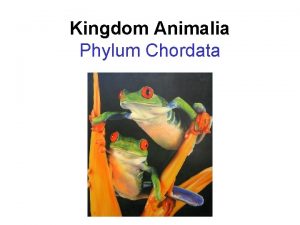Kingdom Animalia Characteristics Eukaryotic Multicellular Heterotrophic ingest food








































- Slides: 40


Kingdom Animalia Characteristics Eukaryotic Multicellular Heterotrophic – ingest food Specialized cells – Most have tissues No cell wall Most motile Most sexual reproduction Diploid is dominant generation

Animals can be distinguished by determining several characteristics. Symmetry – how many lines can be drawn to divide the organism? Tissue- does the organism have tissue and how many layers? Body plan – does the organism have a coelom (body cavity) lined with tissue? Vertebrate or invertebrate – does the organism have a backbone? Skeleton – what kind of skeletal structure does the animal have? Digestion– what kind of digestive system does the animal have?

Types of Body symmetry

Types of body symmetry Asymmetry (lack of symmetry) – Ex = sponges and coral

Types of body symmetry Radial symmetry: body parts arranged around central axis – Ex = hydra and sea stars

Types of body symmetry Bilateral symmetry: body parts can be divided down a central plane – Ex = all higher organisms, humans, insects

Bilateral Symmetry Creates Complexity 95% of animals are invertebrates. There are 29 invertebrate phyla. Most have bilateral symmetry. Body orientation – dorsal (top/back), ventral (bottom/front), anterior (head), posterior (tail)

Cephalization: concentration of nerves and sensory organs at front of organism move easily & sense danger The symmetry of an animal generally fits lifestyle. – Many radial animals are sessile, need to meet the environment equally well from all sides. – Animals that move actively are bilateral; head end is usually first to encounter stimuli

Segmentation: Advanced/complex animals show either internal or external segmentation.

Complex Animals have tissue layers Three Potential Layers of Tissues Formed Ectoderm outer layer Endoderm inner layer Mesoderm middle layer

Types of body plans Acoelomate – Has no coelom (body cavity) surrounding digestive tract – Phyla: Platyhelminthes

Types of body plans Pseudocoelomate – Has coelom surrounding digestive tract but it’s incomplete (not surrounded in mesoderm) – Phylum: Nematods

Types of body plans Coelomate – Has completely lined coelom surrounding digestive tract – Every phylum after Nematoda

Comparison of Body Plans Acoelomate Pseudocoelomate Coelomate

Invertebrate or vertebrate Invertebrates – don’t have a backbone or spinal column Vertebrates – has a backbone and/or spinal column – ONLY animals in Phylum Chordata are vertebrates! squid archaeopteryx

Types of skeletons Exoskeleton – Ex = arthropods Endoskeleton – Ex = mammals

Skeletons Other – Ex = sponges have spicules, sea stars have spiny skin and water vascular systems

Types of digestive systems Incomplete system – (aka one opening for digestion) – Food comes in and out the same place, a mouth

Types of digestive system Complete system – (aka two openings for digestion) – Food comes in a mouth and out the anus!

Phylum Porifera- Sponges Pore-bearing Sessile Body hardened by spicules Asymmetrical Contain cells only Specialized cells for digestion, filter feeders Asexual (budding) and sexual reproduction (hermaphrodites)

Phylum Cnidaria- Cnidarians Hydra, Corals, Jellies Radial symmetry Two tissue layers Incomplete digestioncarnivorous Asexual and sexual reproduction Stinging cellsnematocysts

Phylum Platyhelminthes- Flat Worms Planaria, flukes, tapeworms Bilateral symmetry 3 tissue layers Acoelomates Incomplete digestion Asexual and sexual Parasites and diseases for humans and other animals

Phylum Nematoda- Round worms Ascaris, hookworms, trichinella, pinworms 3 tissue layers Pseudocoelom Two digestive openings Separate sexes Many cause human diseases

Phylum Annelida- Segmented worms Earthworms, leeches, sand worms 3 layers: Coelom Complete digestion Asexual and sexual Circulatory System

Phylum Mollusca- Mollusks Soft body, shells Gastropods (snails), Bivalves (clams), Cephalopods (squid) 3 layers: Coelum Sexual reproduction 3 distinct body parts

Phylum Arthropoda- Arthropods Jointed appendages Classes: – – – Arachnida Crustacea Insecta 3 layers: Coelum Many: internal fertilization Exoskeleton (chitin) ¾ of all animals

Class Arachnida 2 body regions 4 pairs of legs No antennae Book lungs

Class Crustacea 2 body regions 5 pairs walking legs 3 pairs mandibles 2 pairs antennae Gills

Class Insecta 3 body regions 3 pairs walking legs 1 pair antennae Some = flight

Phylum Echinodermata- Echinoderms Spiny skin Sea stars, sand dollars, sea urchins Bilateral then radial 3 layers: Coelum Complete Regeneration/Sexual Endoskeleton and water vascular system Tube feet

Phylum Chordata Dorsal Nerve Cord Vertebrates Tail @ some stage of development Bilateral Symmetry Systems Interact Classes – Agnatha -- Chondrichthyes -- Osteichthyes – Amphibia -- Reptilia -- Aves -- Mammalia

Class Agnatha Jawless fish No scales Long and slender Ectotherm- external temp. regulation

Class Chondrichthyes Cartilaginous fish Tooth-like scales Paired fins Ectothermic Internal fertilization (give birth to live young) Their bone structure is actually cartilage

Class Osteichthyes Bony fish Scales Paired fins Air Bladder 2 chambered heart External fertilization Ectothermic

Class Amphibians Life in water/on land Gills then lungs 3 chambered heart Ectothermic

Class Reptilia Reptiles Dry skin, scales Amniotic egg Lungs Ectothermic

Class Aves Birds Endothermic: body temp. regulated by homeostasis 4 chambered heart Feathers=modified scales

Class Mammalia Mammals Mammary glands Internal development Hair Endothermic

Class Mammalia
 Plantae is prokaryotic or eukaryotic
Plantae is prokaryotic or eukaryotic Heterotrophic eukaryotic organisms
Heterotrophic eukaryotic organisms All animals are multicellular heterotrophs
All animals are multicellular heterotrophs Is protista autotrophic or heterotrophic
Is protista autotrophic or heterotrophic Plantigale
Plantigale Multicellular heterotrophic
Multicellular heterotrophic Multicellular heterotrophic
Multicellular heterotrophic Brittle stars phylum
Brittle stars phylum Animalia kingdom characteristics
Animalia kingdom characteristics Animalia kingdom characteristics
Animalia kingdom characteristics Old kingdom middle kingdom new kingdom
Old kingdom middle kingdom new kingdom Nnn ruled
Nnn ruled Old kingdom middle kingdom new kingdom
Old kingdom middle kingdom new kingdom Mentohotep
Mentohotep Kingdom
Kingdom Kingdom animalia cladogram
Kingdom animalia cladogram Plant - multicellular eukaryote of the kingdom plantae
Plant - multicellular eukaryote of the kingdom plantae Is eubacteria multicellular or unicellular
Is eubacteria multicellular or unicellular Nine phyla of kingdom animalia
Nine phyla of kingdom animalia Kingdom animalia cell structure
Kingdom animalia cell structure Cladogram of kingdom animalia
Cladogram of kingdom animalia Phylum
Phylum Monera, protista, fungi, plantae animalia
Monera, protista, fungi, plantae animalia What are chordata
What are chordata Arthropoda
Arthropoda Domain eukarya kingdom animalia
Domain eukarya kingdom animalia Division of kingdom animalia
Division of kingdom animalia Phylum chordata mammalia
Phylum chordata mammalia Kingdom: animalia phylum: arthropoda class: insecta
Kingdom: animalia phylum: arthropoda class: insecta Domain eukarya, kingdom animalia (or animal)
Domain eukarya, kingdom animalia (or animal) Insects kingdom
Insects kingdom Animalia kingdom
Animalia kingdom Shark class
Shark class Phylum of fish
Phylum of fish Kingdom animalia phylum arthropoda
Kingdom animalia phylum arthropoda Kingdom animalia contains 350 000 species of what
Kingdom animalia contains 350 000 species of what Biology kingdom animalia
Biology kingdom animalia What animal kingdom are axolotls in
What animal kingdom are axolotls in Animal phyla cladogram
Animal phyla cladogram Polifera
Polifera Characteristics of cnidaria
Characteristics of cnidaria

